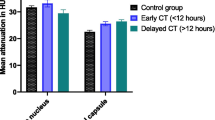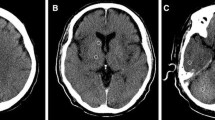Abstract
Brain CT obtained from cardiac arrest (CA) victims immediately after resuscitation may be useful in predicting their outcomes. Most data have been derived from CA victims of cardiac etiology, however, CT signs of brain ischemia/hypoxia have rarely been studied in victims of asphyxial CA. Loss of gray–white matter discrimination (GWMD) at the basal ganglia seems to be the most reliable early CT sign of brain ischemia/hypoxia; a retrospective study was conducted to clarify its incidence, prognostic significance, and temporal profile in resuscitated victims of CA by food asphyxiation. Brain CT scans of each victim were interpreted by two blinded observers. During a 5-year period, 39 resuscitated victims of CA by food asphyxiation underwent brain CT. Thirty-one (79%) showed loss of GWMD, none of whom survived to discharge. Among the other eight victims with seemingly intact brain CT, five (63%) survived to discharge. Loss of GWMD predicted fatality with sensitivity of 100% and specificity of 63%. The interobserver concordance was 82% with kappa coefficient of 0.56. Loss of GWMD developed almost invariably when the asphyxiation–return of spontaneous circulation (ROSC) interval exceeded 10 min. There were five victims with asphyxiation–ROSC interval ≤ 10 min, all of whom survived to discharge. In contrast, none of the 34 victims with the interval >10 min survived to discharge. Loss of GWMD may develop in a relatively time-dependent manner and may be a reliable radiographic indicator of poor outcome in resuscitated victims of asphyxial CA.



Similar content being viewed by others
References
Inamasu J, Miyatake S, Suzuki M et al (2010) Early CT signs in out-of-hospital cardiac arrest survivors: temporal profile and prognostic significance. Resuscitation 81:534–538
Torbey MT, Selim M, Knorr J, Bigelow C, Recht L (2000) Quantitative analysis of the loss of distinction between gray and white matter in comatose patients after cardiac arrest. Stroke 31:2163–2167
Yanagawa Y, Unno Y, Sakamoto T, Okada Y (2005) Cerebral density on CT immediately after a successful resuscitation of cardiopulmonary arrest correlates with outcome. Resuscitation 64:97–101
Choi SP, Park HK, Park KN et al (2008) The density ratio of grey to white matter on computed tomography as an early predictor of vegetative state or death after cardiac arrest. Emerg Med J 25:666–669
International Liaison Committee on Resuscitation (2005) International consensus on cardiopulmonary resuscitation and emergency cardiovascular care science with treatment recommendations. Part 4: advanced life support. Resuscitation 67:213–247
Han BK, Towbin RB, De Courten-Myers G, McLaurin RL, Ball WS Jr (1990) Reversal sign on CT: effect of anoxic/ischemic cerebral injury in children. AJR Am J Roentgenol 154:361–368
Morimoto Y, Kemmotsu O, Kitami K, Matsubara I, Tedo I (1993) Acute brain swelling after out-of-hospital cardiac arrest: pathogenesis and outcome. Crit Care Med 21:104–110
Fujioka M, Okuchi K, Sakaki T, Hiramatsu K, Miyamoto S, Iwasaki S (1994) Specific changes in human brain following reperfusion after cardiac arrest. Stroke 25:2091–2095
Szold O, Reider-Groswasser II, Ben Abraham R et al (2002) Gray-white matter discrimination—a possible marker for brain damage in heat stroke? Eur J Radiol 43:1–5
Vaagenes P, Safar P, Moossy J et al (1997) Asphyxiation versus ventricular fibrillation cardiac arrest in dogs. Differences in cerebral resuscitation effects—a preliminary study. Resuscitation 35:41–52
Oddo M, Ribordy V, Feihl F et al (2008) Early predictors of outcome in comatose survivors of ventricular fibrillation and non-ventricular fibrillation cardiac arrest treated with hypothermia: a prospective study. Crit Care Med 36:2296–2301
McCaul CL, McNamara P, Engelberts D, Slorach C, Hornberger LK, Kavanagh BP (2006) The effect of global hypoxia on myocardial function after successful cardiopulmonary resuscitation in a laboratory model. Resuscitation 68:267–275
Hendrickx HH, Rao GR, Safar P, Gisvold SE (1984) Asphyxia, cardiac arrest and resuscitation in rats. I. Short term recovery. Resuscitation 12:97–116
Manole MD, Foley LM, Hitchens TK et al (2009) Magnetic resonance imaging assessment of regional cerebral blood flow after asphyxial cardiac arrest in immature rats. J Cereb Blood Flow Metab 29:197–205
Zhang B, Wei X, Cui X, Kobayashi T, Li W (2008) Effects of heme oxygenase 1 on brain edema and neurologic outcome after cardiopulmonary resuscitation in rats. Anesthesiology 109:260–268
Author information
Authors and Affiliations
Corresponding author
Rights and permissions
About this article
Cite this article
Inamasu, J., Miyatake, S., Nakatsukasa, M. et al. Loss of gray–white matter discrimination as an early CT sign of brain ischemia/hypoxia in victims of asphyxial cardiac arrest. Emerg Radiol 18, 295–298 (2011). https://doi.org/10.1007/s10140-011-0954-7
Received:
Accepted:
Published:
Issue Date:
DOI: https://doi.org/10.1007/s10140-011-0954-7




